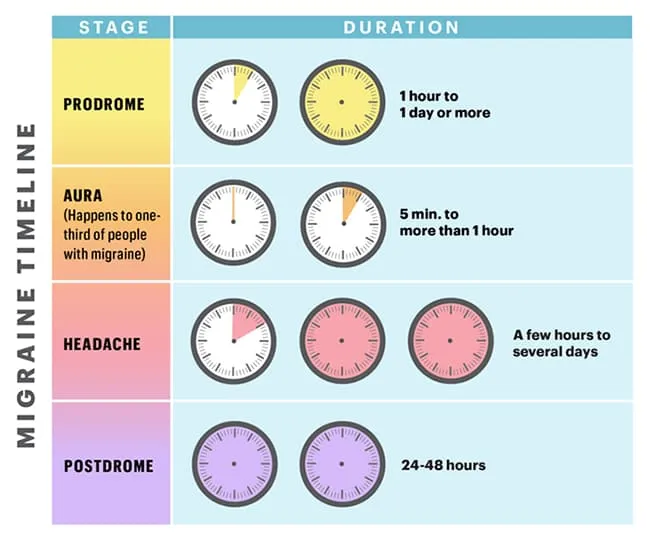How Long Do Migraines Last?
How long a migraine's symptoms last can be different for everyone. But many times, an attack follows the same pattern. These migraine stages include:
- Prodrome phase
- Aura
- Headache
- Postdrome phase
Untreated migraines usually last a day or two. Rarely, it may last a little over a week. You might have a headache for 4-72 hours.
Knowing more about migraine stages can help you predict and prepare for an attack.

Prodrome Phase
Before migraine pain hits, you may go through the prodrome phase, also called the “preheadache” phase. It can last from an hour up to a day or more. This phase may not occur before every migraine attack but affects about 77% of people before they have a headache. It's more common in people assigned female at birth than in those assigned male at birth.
Prodrome phase symptoms
The warning signs you have will be unique to you. Common ones include:
- Feeling irritable
- Sudden mood changes
- Yawning a lot
- Needing to pee more than usual
- Craving certain foods
- Extra sensitivity to light or sound
- Trouble concentrating
- Feeling tired and stiff
- Trouble talking or reading
- Nausea
- Trouble sleeping
- Feeling sluggish
- Neck pain
- Restlessness
- Vision problems (difficulty focusing)
- Feeling cold
- Sweating
- Feeling thirsty
- Having too much energy
Prodrome phase treatment
Once you know the symptoms of your prodrome phase, you may be able to figure out steps that could ease your migraine attack or even stop it from happening.
Those steps may include:
- Medication
- Relaxation techniques such as meditation
- Avoiding triggers that will make your migraine worse
Aura Phase
About 25%-30% of people with migraines get an aura along with it. An aura involves different sensory disturbances and typically happens before your migraine pain. An aura could last anywhere from 5 minutes to more than an hour. Some people get them after their pain has already started.
Aura phase symptoms
Most of the symptoms of an aura have to do with your sight. They might include:
- Blurry vision
- Blind spots in one or both eyes
- Flashing lights
- Zigzags or patterns in your sight
You can also have symptoms that don’t have anything to do with your sight, such as:
- Numbness or tingling
- Vertigo
- Weakness
- Trouble speaking or hearing
- Memory problems
Aura phase treatment
There’s not much you can do to keep an aura from happening. But understanding that a migraine will follow an aura can help you know it’s time to take medication that may ease or prevent oncoming migraine pain.
These same symptoms can also signal a stroke, so if a doctor hasn’t diagnosed these symptoms as part of your migraine, get medical help right away.
Headache Phase
When you have a headache as part of a migraine attack, it can start as a dull ache that worsens within minutes or hours. Sometimes, it's possible to have a migraine without a headache.
Headache phase symptoms
Headaches usually start with throbbing, pulsing pain on one or both sides of your head. The pain may last only a few hours or could continue for several days. It may be minor or very severe.
Other symptoms you could have, either with or without head pain, include:
- Sensitivity to lights, sounds, and smells
- Nausea or vomiting
- Blurred vision
- Lightheadedness and fainting
Headache phase treatment
Your doctor can help you choose medication to make your experience less severe. Headache medications they may recommend include:
Pain relief medications. Nonsteroidal anti-inflammatory drugs (NSAIDs) such as aspirin, acetaminophen, ibuprofen, naproxen, and diclofenac may help if you have a mild or moderate headache with no nausea or vomiting. You can get these medicines over the counter.
Triptans. If you don't feel better after taking pain relief drugs for a headache, your doctor may recommend triptans, including:
- Almotriptan
- Eletriptan
- Frovatriptan
- Naratriptan
- Rizatriptan
- Sumatriptan
- Zolmitriptan
A triptan could be in nasal spray, injection, or oral tablet form. It works by interrupting the process that leads to a migraine and treating the pain. You shouldn’t take triptans for more than 9 days a month to avoid getting headaches due to medication overuse.
You shouldn't take triptans if you are pregnant or have certain health conditions, such as:
- Hemiplegic migraine (a rare disorder that causes you to have headache and muscle weakness on one side of the body)
- Basilar migraine (a rare migraine)
- Uncontrolled high blood pressure
- Heart problems
- Stroke
Ergot derivatives. Ergotamine and dihydroergotamine work like triptans. A doctor may recommend ergots in rare cases, like if you have a headache from overusing headache medications. More research is needed to understand how well they work, and they may cause serious side effects. Don’t take them if you have heart disease or high blood pressure.
To prevent your headache from getting more intense, lie in a dark and quiet room, apply a cold washcloth to the back of your neck, or practice other relaxation techniques.
Postdrome Phase
Even if your migraine attack symptoms go away, your migraine may not be over. Many people have a last phase called the postdrome phase, or a “migraine hangover.”
Postdrome phase symptoms
The postdrome phase doesn’t involve pain like the headache phase, but it can cause other symptoms for 24-48 hours after your migraine ends. These symptoms include:
- Trouble concentrating
- Fatigue
- Depression
- Euphoria
- Trouble understanding things
- Body aches
- Dizziness
- Sensitivity to light
Postdrome phase treatment
Even though your migraine attack is over at this point, it’s still a good idea to stay away from your migraine triggers, such as bright light and certain smells or foods.
You can try gentle stretching or yoga to help with sore muscles that might have been tense during your attack.
Be sure to drink plenty of water and avoid stress as you recover.
Understanding Your Migraine Phases
To better understand your migraines, keep a headache diary to track your symptoms and how they happen.
Your diary may also help your doctor determine the best ways to prevent your migraines from happening or worsening.
Some questions to answer in your diary and share with your doctor include:
- When did the migraine or pain start?
- Where does it hurt?
- How painful is it?
- What does the pain feel like?
- How long does the pain last?
- Has the headache gotten better or worse since it started?
- How often do you have migraines?
- Do you notice anything that triggers your migraines?
- What other symptoms do you have with your migraines?
- Does sleep affect your migraines?
- What medications do you take to feel better?
- How often do you take these medications?
Takeaways
Migraines often appear in four stages: prodrome, aura, headache, and postdrome. Your migraine may last a day or two without treatment. It's important to talk to your doctor about the best form of treatment for you, especially if you have serious migraines that don’t go away with pain relief medicines and relaxation exercises. If you have migraines often, you can start a headache diary. This will help you understand your triggers and remedies that work best to prevent them or relieve them when they happen.
Migraine Stages FAQs
What is the fastest way to get rid of a migraine?
The fastest way to get rid of a migraine is by taking over-the-counter pain relief medicines such as ibuprofen, diclofenac, and acetaminophen. You can also help manage your pain without medication by:
- Lying in a cool, quiet, and dark room
- Drinking water or small amounts of a caffeinated beverage
- Placing heating pads or ice packs on your neck and forehead
Can a hot shower help with migraines?
A hot shower may ease a migraine by relaxing your muscles.
Is heat or ice better for migraines?
Both options may help improve your migraine symptoms. You can experiment with both and choose the one that works best for you.

